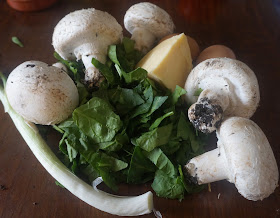 |
| Mushrooms are almost 3 inches across! |
Having already enjoyed my annual Holy Week bacalao day, I am finishing the week with vegetarian meals. Today’s was inspired by a lucky find at the market—huge mushrooms. I couldn’t bear to slice them up. These beauties were meant for stuffing.
The stuffing is chopped spinach mixed with beaten egg that bakes with a cheesy topping. Baking the mushrooms briefly before stuffing allows some of their moisture to cook out so that it doesn’t mix with the raw egg in the stuffing mix.
 |
| Big, meaty mushrooms are perfect for stuffing. |
 |
| Serve the mushrooms as a starter. |
Stuffed Mushrooms
Champiñones Rellenos
Serve the mushrooms, one per person, as an appetizer or starter, or two or three on a bed of rice for a main dish.
5-6 large (2 ½ inch-) mushrooms (1 pound)
2 tablespoons olive oil + additional for the pan
1 cup chopped spinach, packed (2 ounces)
¼ cup chopped scallions
2 eggs
½ teaspoon salt
Freshly ground black pepper
3 tablespoons grated cheese
Arugula to serve
Preheat oven to 375ºF.
Clean the mushrooms by wiping them with a damp cloth. Twist the stems and remove them, leaving hollows for the stuffing. (Save the stems for another use.) Lightly oil an oven pan. Set the mushrooms in it, hollow side down. Drizzle a little oil over the mushrooms. Bake them for 8 minutes.
Heat the oil in a small skillet. Sauté the spinach and scallions until spinach is wilted and all the liquid has cooked off, 3 to 5 minutes. Remove from the heat.
Beat the eggs in a bowl with the salt and pepper. Add the spinach and mix well.
 |
| Mushroom caps baked with spinach, egg, cheese. |
Remove the mushrooms from the oven. Turn them right side up. Fill the mushrooms with the egg-spinach mixture. Top the mushrooms with grated cheese.
Bake the mushrooms until the eggs are set and top lightly browned, about 15 minutes.
Serve the mushrooms hot or room temperature. Garnish with arugula or salad greens.
Another way to stuff a mushroom: Quail Eggs in Mushroom Nests.


































